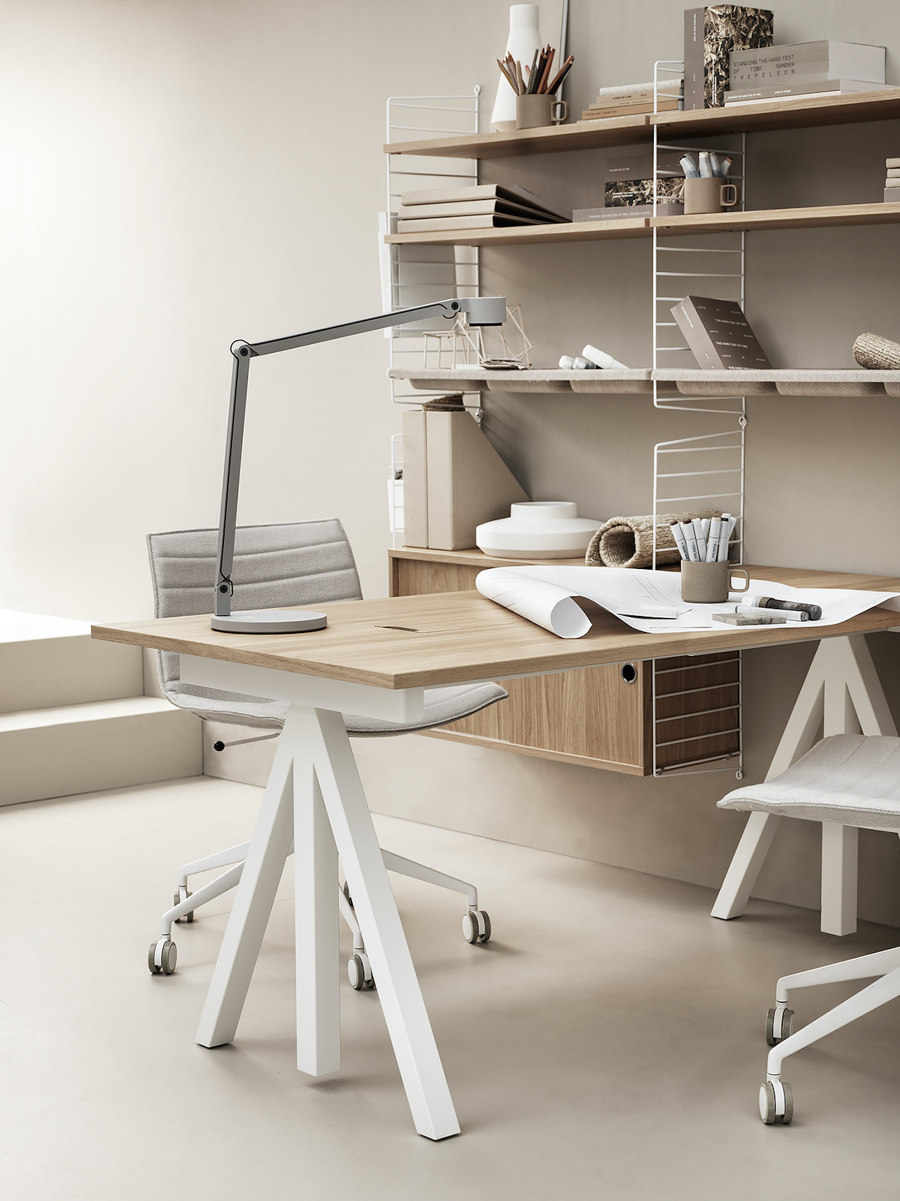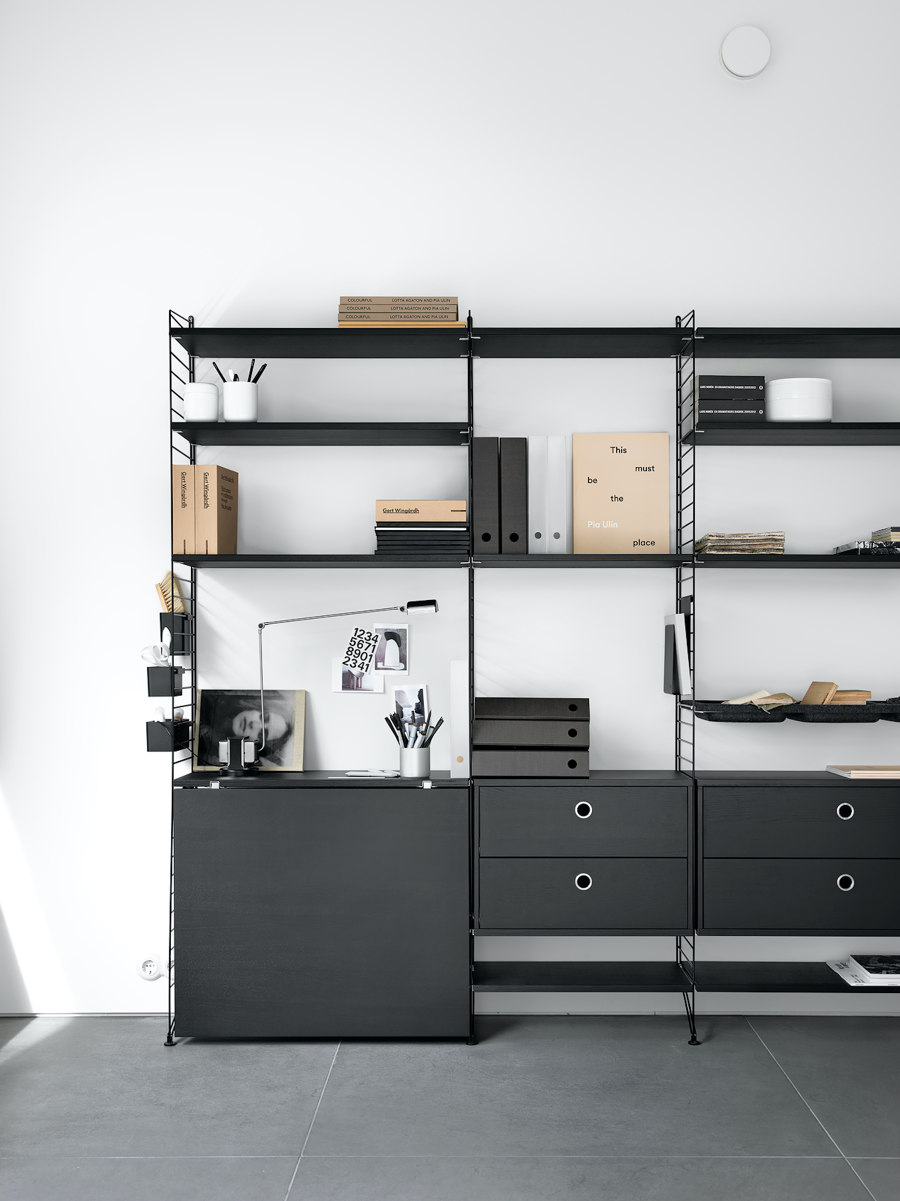Get a job!: String Works
Brand story by Jean-Christophe Camuset
Malmö, Suède
02.12.20
The STRING shelf may be an icon, but it’s not resting on its laurels. On the contrary, it’s aiming to prove itself anew in a different environment: the office.
Example of a perfect ‘home office’ environment created with elements of the Home collection (String Furniture)

Example of a perfect ‘home office’ environment created with elements of the Home collection (String Furniture)
×When Bjorn Dahlström and Anna Von Schewen first started working on a new collection for String Furniture from home, it was far from clear that soon much of the world would be joining them in the home-office. What was clear, however, was the brief from the Swedish furniture brand: they wanted to create a collection around their String Shelf. Designed in 1949, this piece of furniture made its way into countless Swedish and international homes, thanks to its simplicity, ergonomy and durability, and in 2005, was relaunched on the market, confirming its iconic status.
‘We wanted to preserve the legacy of this iconic shelf but extend its DNA’
‘It’s not easy to work on such an icon… This shelf is in everybody’s home in Sweden but it’s not common in offices. Our aim was to conquer these new territories’, say the designers from their Stockholm studio. Since 2017, the whole String system has been updated in order to adapt to different rooms and spaces. ‘We wanted to preserve the legacy of this iconic shelf but extend its DNA’, notes Peter Erlander, CMO and co-founder.
Top: The collection’s DNA lies in the iconic String shelf (1949). Middle: The grid system allows easy installation of a desk between two shelves. Above: After a preliminary survey, the designers decided to add a sit-stand desk to the ‘Works’ collection

Top: The collection’s DNA lies in the iconic String shelf (1949). Middle: The grid system allows easy installation of a desk between two shelves. Above: After a preliminary survey, the designers decided to add a sit-stand desk to the ‘Works’ collection
×Bjorn Dahlström and Anna von Schewen started building the collection around the sit-stand table. In fact, the designers began by speaking to physicians, who convinced them that changing position throughout the day was crucial for avoiding a vast array of health issues. Usually, these kinds of desks are bulky and very technical. Their aesthetics scream ‘office’ and they don’t fit readily into a domestic environment.
That’s why they decided to design a table and not a desk. ‘It’s meant to be a dining table in the early morning and then turn into a desk during the day or a drawing space for kids in the afternoon’, says Peter Erlandsson. ‘It’s ideal for young, urban adults who have to deal with tiny spaces. But it also works perfectly in offices as well.’
‘With this collection, we wanted to fill the gap between these environments. Our work focused on the technical details, how to hide them in order to make this collection as suitable for domestic interiors as for offices’, explain the designers.
Top: The sit-stand desk hides its periscope in a central leg. Above: The String Shelf was designed in 1949, but it’s still perfect for working in 2020

Top: The sit-stand desk hides its periscope in a central leg. Above: The String Shelf was designed in 1949, but it’s still perfect for working in 2020
×To that end, they visited String Furniture suppliers and asked for the smallest table-top-adjusting mechanism available. They hid the mechanism along the periscope, which allows the tabletop to move between 71.5cm and 118 cm, on a third leg. Their aim was to mimic the trestles many workers use as desks. The end result is that the sit-stand table blends as seamlessly into a home environment as into a working one.
‘It’s ideal for young, urban adults who have to deal with tiny spaces. But it also works perfectly in offices as well’
Their second task was to design – you guessed it – a shelf! Unlike the traditional String model, they wanted this one to be self-standing so it could be assembled without a wall. They first designed a movable partition, a metal structure filled with a felt panel, in order to absorb the noises of people chatting around the coffee machine or kids playing nearby. The panel exterior has two wire screens where different containers can hang.
The duo eventually designed filing cabinets and storage on wheels, with handles which are an explicit reference to the original design of the String Shelf. Their wheels make them a perfect choice for ‘flexi-offices’, where workers have to move their things to a different place everyday. The upper part includes two shallow areas for storing pencils, rubbers and other stationary, so they don’t fall on the floor when the storage unit is moved around.
The String Furniture family includes a folding table which blends seamlessly into the background when not in use

The String Furniture family includes a folding table which blends seamlessly into the background when not in use
×Since its reboot, the String shelf system has become well known for its large choice of bright and vibrant colours. But for the Works collection, Bjorn and Anna decided to keep things simple: only one option is available: white. ‘Because it’s discreet and suits offices just as well as homes.’
In addition to the Works collection, String Furniture recently released a side table, newly designed by TAF architects for the National Museum in Stockholm. Despite it initially being made to support busts or sculptures, it’s also a perfect stand to put your laptop on when you’re working from your sofa.
So whatever your needs for remote working, you’re sure to find the right solution in the String Furniture collections.
© Architonic












